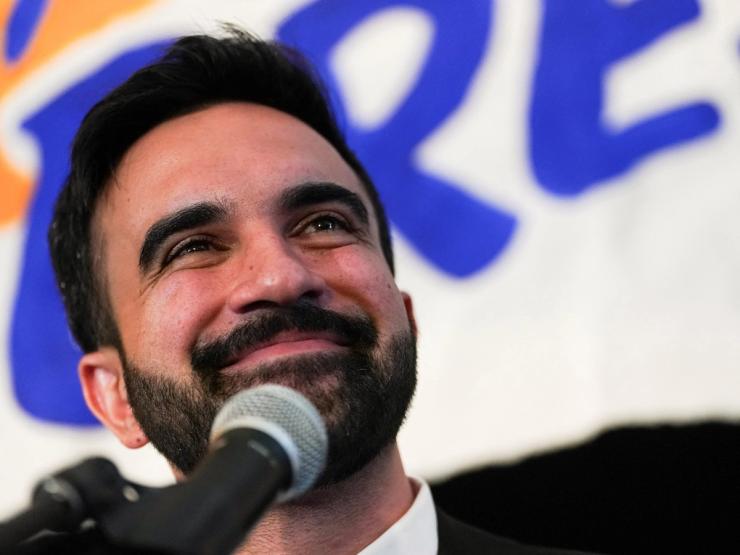The News
Hours after Zohran Mamdani announced his candidacy for mayor at a rally last October, one member of the New York Post’s editorial board fired off a post on X.
“Is it true that no pagers were allowed?” Michael Benjamin wrote.
It was a cheap shot, implying the left-wing Muslim politician had ties to Hezbollah. The Post, like much of New York city’s establishment, was already dismissing Mamdani as too extreme to win in the Democratic mayoral primary.
But months later, Benjamin reached out to Mamdani’s campaign directly, an aide said, inviting the candidate to meet the influential right-wing tabloid’s editorial board. In the months since the tweet, the 33-year-old Democratic socialist had gone from an obscure New York assemblyman to an increasingly potent political force. Now, the editorial board planned to grill him over his plans for the city and its disagreements with him over Israel.
Mamdani’s campaign officials had not forgotten Benjamin’s pager crack (and subsequent tweets rehashing the same material), and weighed whether to sit down with the Post, which had ratcheted up its criticism of him as he rose in the polls. Mamdani never got around to it, and the Post never followed up.
It didn’t matter. The young Democratic socialist swept the primary on the back of a media strategy fit for 2025: clever short-form vertical videos, intense message discipline focused on affordability, and an openness to talking to anyone — from niche menswear fashion podcasts to legacy players.
Now, following his shocking primary showing, and with a grab bag of damaged candidates running to his right, the Post may be Mamdani’s most formidable opponent in November’s general election. The friction between Mamdani and the paper is an ideological battle over New York, but it is also a battle of two different forms of media: the old-school lurid local tabloid against the new-media-savvy upstart.
In this article:
Know More
Mamdani entered his longshot bid for mayor with the idea that in order to win, the campaign would need to “create its own attention environment,” according to his chief spokesperson, Andrew Epstein. At that point, the campaign was largely concerned about whether it had the creative juice to introduce an unknown assemblyman to a disillusioned Democratic base whose voters were tuning out all political news in the wake of Donald Trump’s reelection.
With a limited budget, that meant focusing on making creative videos that could showcase Mamdani’s personality and generate earned media by getting the attention of legacy media outlets. This became the bread and butter of the campaign. Mamdani first went viral when he interviewed Trump supporters in Queens about why they voted for the president in 2024. His video talking about the price of halal food, and the city regulations that halal cart owners faced got tens of thousands of likes on Instagram.
In March, Mamdani called his communications director, saying that Trump border czar Tom Homan was visiting New York’s capitol in Albany that day. The campaign discussed how Mamdani should handle Homan’s visit, and whether he should take the opportunity to ask him about the detention of Mahmoud Khalil, the pro-Palestinian Columbia campus activist. They decided that the assemblyman should, if given the opportunity, confront Homan by asking him if he believed in the 1st Amendment.
Mamdani squared off with Homan in the hallway, and after taking a video on his phone, Epstein said he downloaded the short-form video production app CapCut, quickly added captions to the footage, and posted it. It quickly racked up millions of views, and landed Mamdani his first primetime cable news hit later that week on CNN.
When Mamdani launched his campaign, he had 14,000 Instagram followers on his personal account. By last Tuesday, he had reached 1 million. (In the five days since the primary, he’s gained an additional 1.6 million followers.)
When it came to the Post, the campaign knew it had to engage, given the paper’s relentless coverage of the race. The campaign decided it would ignore the Post’s editorial board, but took seriously the paper’s beat reporters, who command the respect of many New York political professionals.
“We always knew we wanted to engage with even hostile media,” his communications director told Semafor. “We knew we would be something between a fascination and a menace for the Post.”
The Mamdani campaign believed it could tell a compelling story about economic populism through the Post’s own stories, such as a negatively-framed report about Mamdani’s proposed tax hikes on corporations to pay for what the paper called “freebies.” The campaign would also post screengrabs of New York Post headlines meant to upset conservative readers that the campaign thought made Mamdani look good.
“The Post had scary headlines,” Epstein told Semafor. “We’d put them on Instagram and Twitter and they would go viral. The populist economic stuff was good for us.”
Step Back
The New York Post had a complicated relationship with Mario Cuomo, opposing many of his liberal policies, but has acknowledged that he’d saved it from financial ruin in 1993. It has been at least as hard on his son, delivering relentlessly critical coverage of everything from Cuomo’s handling of the pandemic to allegations of sexual misconduct, and playing a central role in the public fracturing of his marriage to Kerry Kennedy, which ended in 2005.
But in the spring, Cuomo’s top campaign advisors believed that they had finally won over the begrudging Post. The paper was out of other good options: Its choice candidate, New York City mayor Eric Adams, declined to participate in the Democratic primary, after his political capitulation to the Trump administration in exchange for a legal reprieve. The rest of the field was running to the left, especially Mamdani, who was starting to gain traction. Advisers privately telegraphed to reporters that they believed, seeing the field, the Post would have no choice but to choose Cuomo as the sensible, moderate voice who could beat back the progressives.
Cuomo’s advisers were wrong.
Instead, the Post trained its editorial fire on the former New York governor, publishing an unrelenting slew of negative pieces. Rival campaigns, desperate to remind Democratic primary voters of their distaste for Cuomo, shopped opposition research to the Post, some of which it picked up and ran. The paper described Cuomo’s hours-long interview in March as “testy.”
The Post’s continued anti-Cuomo posture created an opening for Mamdani. In a since-deleted tweet, Cuomo top adviser Richard Azzopardi said the Post “actively worked to elect Mamdani.”
“The Post did not take Mamdami seriously until the end,” one rival campaign source told Semafor.
Mamdani’s campaign didn’t disagree.
“By the time [The Post] put their full blasters on us, we had already built a platform,” he said.
The View From Astoria
As New York’s center and right choose among bad options, Mamdani’s campaign is planning on meeting with the top newspaper editors and TV executive producers for an informal general election campaign reset. His staff is hoping to establish strong lines of communication and express where the campaign feels news organizations have misunderstood Mamdani, especially his views on Middle East politics.
The campaign will also have to alter its wildly effective communications style. Previously, Mamdani could do man-on-the-street style videos in which he rode the subway with other New Yorkers, or interviewed local business owners and Trump voters who had little idea of who he was. A campaign source acknowledged that it will have to get more creative because of Mamdani’s elevated profile: He’s too recognizable now to pull off some of the early campaign stunts, and he has a new wave of voters to persuade.
Meanwhile, Cuomo is deciding whether to reboot his campaign and run under a different party line in the general election, where he would face Adams and Republican Curtis Sliwa. Any constellation of opponents, though, will have a tough battle against Mamdani. Sliwa and Adams, and possibly Cuomo, could split the moderate vote, while Mamdani will likely consolidate support among labor unions and Democratic elected officials.
Max’s view
Mamdani’s ascendancy also comes at an unusual moment for News Corp.’s New York paper, which now occupies a unique place in the American media landscape. Once one of dozens of big-city tabloids, the Post now stands alone as the last truly influential local tabloid. Its old business model — local ads and printed papers — has long since declined, and the paper has reinvented itself primarily as a national online brand led by Daily Mail alum Keith Poole.
But the Post has a special place in Rupert Murdoch’s heart, and in Trump’s. The tabloid has thrived in recent years as an oppositional force to Democratic politicians. Its coverage of the Hunter Biden laptop story helped send its online web traffic soaring and made it profitable for several years. While a recent News Corp investor report said the Post’s web traffic had dipped, the national media’s focus on Mamdani and his plans to change New York could provide good fodder for the paper and segments on Fox News.
Asked about the Post’s position on the mayor’s race going forward, a spokesperson said: “We’d just say the Post coverage will provide the answers — so make sure to read closely.”
Notable
- In the beginning, the campaign had to chase local television to get much press. Mamdani’s communications chief recalled a press conference the campaign did for tenants rights. The only journalists who showed up were a reporter from Politico, which was early to recognize the potency of Mamdani’s campaign, and a student journalist from Columbia University.
- Mamdani consultant Morris Katz, of the firm Fight, joined him after running an unusual Senate campaign for independent Dan Osborn in Nebraska. Katz’s strategy: “Let Zohran cook.”


